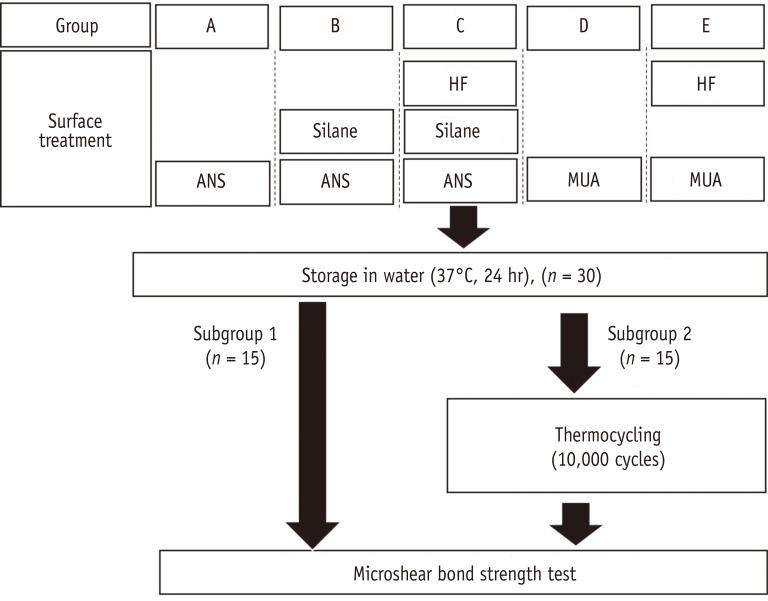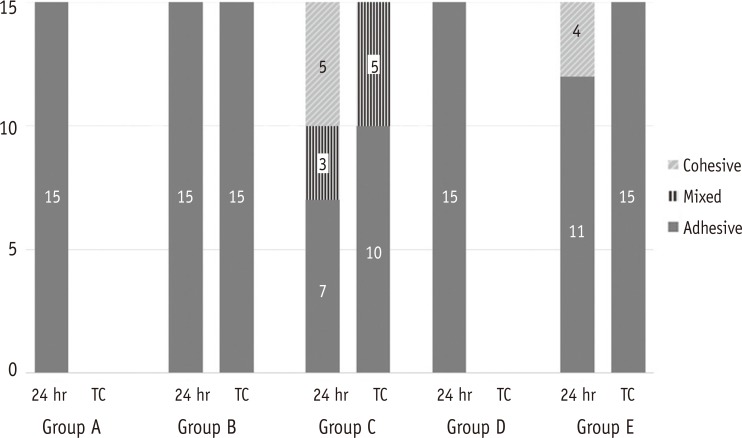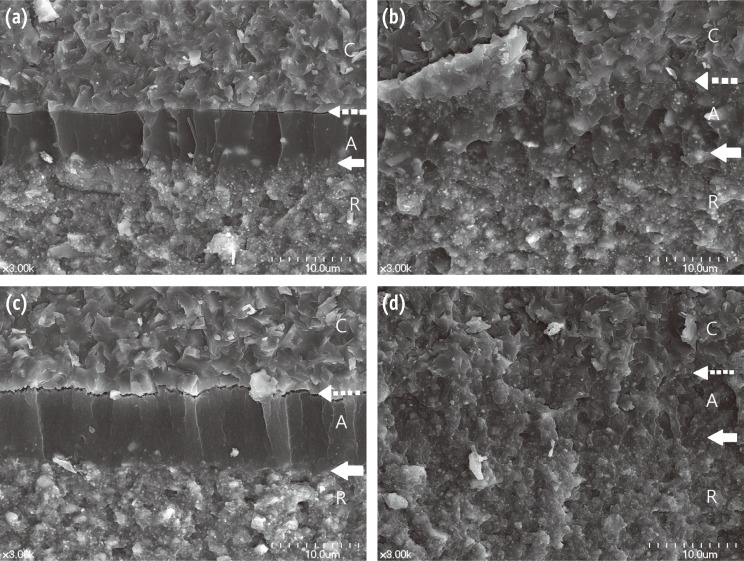Restor Dent Endod.
2017 May;42(2):95-104. 10.5395/rde.2017.42.2.95.
Bonding of the silane containing multi-mode universal adhesive for lithium disilicate ceramics
- Affiliations
-
- 1Department of Conservative Dentistry, Seoul National University School of Dentistry and Dental Research Institute, Seoul, Korea. hhson@snu.ac.kr
- 2Department of Dental Biomaterials Science, Seoul National University School of Dentistry and Dental Research Institute, Seoul, Korea.
- 3Special Care Clinic, Seoul National University Dental Hospital, Seoul, Korea.
- KMID: 2379458
- DOI: http://doi.org/10.5395/rde.2017.42.2.95
Abstract
OBJECTIVES
This study evaluated the influence of a multi-mode universal adhesive (MUA) containing silane (Single Bond Universal, 3M EPSE) on the bonding of resin cement to lithium disilicate.
MATERIALS AND METHODS
Thirty IPS e.max CAD specimens (Ivoclar Vivadent) were fabricated. The surfaces were treated as follows: Group A, adhesive that did not contain silane (ANS, Porcelain Bonding Resin, Bisco); Group B, silane (S) and ANS; Group C, hydrofluoric acid (HF), S, and ANS; Group D, MUA; Group E, HF and MUA. Dual-cure resin cement (NX3, Kerr) was applied and composite resin cylinders of 0.8 mm in diameter were placed on it before light polymerization. Bonded specimens were stored in water for 24 hours or underwent a 10,000 thermocycling process prior to microshear bond strength testing. The data were analyzed using multivariate analysis of variance (p < 0.05).
RESULTS
Bond strength varied significantly among the groups (p < 0.05), except for Groups A and D. Group C showed the highest initial bond strength (27.1 ± 6.9 MPa), followed by Group E, Group B, Group D, and Group A. Thermocycling significantly reduced bond strength in Groups B, C, and E (p < 0.05). Bond strength in Group C was the highest regardless of the storage conditions (p < 0.05).
CONCLUSIONS
Surface treatment of lithium disilicate using HF and silane increased the bond strength of resin cement. However, after thermocycling, the silane in MUA did not help achieve durable bond strength between lithium disilicate and resin cement, even when HF was applied.
MeSH Terms
Figure
Cited by 1 articles
-
Influence of surface treatments and repair materials on the shear bond strength of CAD/CAM provisional restorations
Ki-Won Jeong, Sung-Hun Kim
J Adv Prosthodont. 2019;11(2):95-104. doi: 10.4047/jap.2019.11.2.95.
Reference
-
1. Bergmann CP, Stumpf A. Dental ceramics: microstructure, properties and degradation. Berlin Heidelberg: Springer Science & Business Media;2013. Chapter 1.2. Rosenblum MA, Schulman A. A review of all-ceramic restorations. J Am Dent Assoc. 1997; 128:297–307. PMID: 9066214.
Article3. Zhang Y, Lee JJ, Srikanth R, Lawn BR. Edge chipping and flexural resistance of monolithic ceramics. Dent Mater. 2013; 29:1201–1208. PMID: 24139756.
Article4. Tysowsky GW. The science behind lithium disilicate: a metal-free alternative. Dent Today. 2009; 28:112–113.5. Gorodovsky S, Zidan O. Retentive strength, disintegration, and marginal quality of luting cements. J Prosthet Dent. 1992; 68:269–274. PMID: 1501173.
Article6. El-Mowafy O. The use of resin cements in restorative dentistry to overcome retention problems. J Can Dent Assoc. 2001; 67:97–102. PMID: 11253298.7. Rosentritt M, Behr M, Lang R, Handel G. Influence of cement type on the marginal adaptation of all-ceramic MOD inlays. Dent Mater. 2004; 20:463–469. PMID: 15081553.
Article8. Alber FE, El-Mowafy OM. Marginal adaptation and microleakage of Procera AllCeram crowns with four cements. Int J Prosthodont. 2004; 17:529–535. PMID: 15543909.9. Sorensen JA, Kang SK, Avera SP. Porcelain-composite interface microleakage with various porcelain surface treatments. Dent Mater. 1991; 7:118–123. PMID: 1718804.
Article10. Jensen ME, Sheth JJ, Tolliver D. Etched-porcelain resin-bonded full veneer crowns: in vitro fracture resistance. Compendium. 1989; 10:336–347. PMID: 2605607.11. Nagai T, Kawamoto Y, Kakehashi Y, Matsumura H. Adhesive bonding of a lithium disilicate ceramic material with resin-based luting agents. J Oral Rehabil. 2005; 32:598–605. PMID: 16011639.
Article12. Filho AM, Vieira LC, Araújo E, Monteiro Júnior S. Effect of different ceramic surface treatments on resin microtensile bond strength. J Prosthodont. 2004; 13:28–35. PMID: 15032893.
Article13. Menees TS, Lawson NC, Beck PR, Burgess JO. Influence of particle abrasion or hydrofluoric acid etching on lithium disilicate flexural strength. J Prosthet Dent. 2014; 112:1164–1170. PMID: 24951390.
Article14. Kang SH, Chang J, Son HH. Flexural strength and microstructure of two lithium disilicate glass ceramics for CAD/CAM restoration in the dental clinic. Restor Dent Endod. 2013; 38:134–140. PMID: 24010079.
Article15. Della Bona A, Shen C, Anusavice KJ. Work of adhesion of resin on treated lithia disilicate-based ceramic. Dent Mater. 2004; 20:338–344. PMID: 15019447.
Article16. Alex G. Preparing porcelain surfaces for optimal bonding. Compend Contin Educ Dent. 2008; 29:324–335. PMID: 18795637.17. Van Meerbeek B, De Munck J, Yoshida Y, Inoue S, Vargas M, Vijay P, Van Landuyt K, Lambrechts P, Vanherle G. Adhesion to enamel and dentin: current status and future challenges. Oper Dent. 2003; 28:215–235. PMID: 12760693.18. Kadoma Y. Surface treatment agent for dental metals using a thiirane monomer and a phosphoric acid monomer. Dent Mater J. 2002; 21:156–169. PMID: 12238784.
Article19. Chen L, Suh BI, Brown D, Chen X. Bonding of primed zirconia ceramics: evidence of chemical bonding and improved bond strengths. Am J Dent. 2012; 25:103–108. PMID: 22779284.20. Fukegawa D, Hayakawa S, Yoshida Y, Suzuki K, Osaka A, Van Meerbeek B. Chemical interaction of phosphoric acid ester with hydroxyapatite. J Dent Res. 2006; 85:941–944. PMID: 16998137.
Article21. Alex G. Universal adhesives: the next evolution in adhesive dentistry? Compend Contin Educ Dent. 2015; 36:15–26. PMID: 25822403.22. Suzuki T, Takamizawa T, Barkmeier WW, Tsujimoto A, Endo H, Erickson RL, Latta MA, Miyazaki M. Influence of etching mode on enamel bond durability of universal adhesive systems. Oper Dent. 2016; 41:520–530. PMID: 27351078.
Article23. Sai K, Shimamura Y, Takamizawa T, Tsujimoto A, Imai A, Endo H, Barkmeier WW, Latta MA, Miyazaki M. Influence of degradation conditions on dentin bonding durability of three universal adhesives. J Dent. 2016; 54:56–61. PMID: 27645112.
Article24. Passia N, Mitsias M, Lehmann F, Kern M. Bond strength of a new generation of universal bonding systems to zirconia ceramic. J Mech Behav Biomed Mater. 2016; 62:268–274. PMID: 27232829.
Article25. Kim JH, Chae SY, Lee Y, Han GJ, Cho BH. Effects of multipurpose, universal adhesives on resin bonding to zirconia ceramic. Oper Dent. 2015; 40:55–62. PMID: 25084107.
Article26. Kalavacharla VK, Lawson NC, Ramp LC, Burgess JO. Influence of etching protocol and silane treatment with a universal adhesive on lithium disilicate bond strength. Oper Dent. 2015; 40:372–378. PMID: 25535784.
Article27. Han GJ, Chung SN, Chun BH, Kim CK, Oh KH, Cho BH. Effect of the applied power of atmospheric pressure plasma on the adhesion of composite resin to dental ceramic. J Adhes Dent. 2012; 14:461–469. PMID: 22724108.28. Braga RR, Meira JB, Boaro LC, Xavier TA. Adhesion to tooth structure: a critical review of ‘macro’ test methods. Dent Mater. 2010; 26:e38–e49. PMID: 20004960.
Article29. Pashley DH, Carvalho RM, Sano H, Nakajima M, Yoshiyama M, Shono Y, Fernandes CA, Tay F. The microtensile bond test: a review. J Adhes Dent. 1999; 1:299–309. PMID: 11725659.30. Armstrong S, Geraldeli S, Maia R, Raposo LH, Soares CJ, Yamagawa J. Adhesion to tooth structure: a critical review of ‘micro’ bond strength test methods. Dent Mater. 2010; 26:e50–e62. PMID: 20045179.31. Kim JH, Chae S, Lee Y, Han GJ, Cho BH. Comparison of shear test methods for evaluating the bond strength of resin cement to zirconia ceramic. Acta Odontol Scand. 2014; 72:745–752. PMID: 24697713.
Article32. Arkles B, Steinmetz JR, Zazyczny J, Mehta P. Factors contributing to the stability of alkoxysilanes in aqueous solution. J Adhes Sci Technol. 1992; 6:193–206.
Article33. Brochier Salon MC, Bayle PA, Abdelmouleh M, Boufi S, Belgacem MN. Kinetics of hydrolysis and self condensation reactions of silanes by NMR spectroscopy. Coll Surf Physicochem Eng Asp. 2008; 312:83–91.
Article34. Lung CY, Matinlinna JP. Aspects of silane coupling agents and surface conditioning in dentistry: an overview. Dent Mater. 2012; 28:467–477. PMID: 22425571.
Article35. Zaghloul H, Elkassas DW, Haridy MF. Effect of incorporation of silane in the bonding agent on the repair potential of machinable esthetic blocks. Eur J Dent. 2014; 8:44–52. PMID: 24966745.
Article36. Fox MA, Whitesell JK. Organic chemistry. 3rd ed. Sudbury: Jones and Bartlett Publishers;2004. Chapter 16.37. Pashley EL, Zhang Y, Lockwood PE, Rueggeberg FA, Pashley DH. Effects of HEMA on water evaporation from water-HEMA mixtures. Dent Mater. 1998; 14:6–10. PMID: 9972145.
Article38. Guarda GB, Correr AB, Gonçalves LS, Costa AR, Borges GA, Sinhoreti MA, Correr-Sobrinho L. Effects of surface treatments, thermocycling, and cyclic loading on the bond strength of a resin cement bonded to a lithium disilicate glass ceramic. Oper Dent. 2013; 38:208–217. PMID: 22856682.
Article39. Borges GA, Sophr AM, De Goes MF, Sobrinho LC, Chan DC. Effect of etching and airborne particle abrasion on the microstructure of different dental ceramics. J Prosthet Dent. 2003; 89:479–488. PMID: 12806326.
Article40. Lise DP, Perdigão J, Van Ende A, Zidan O, Lopes GC. Microshear bond strength of resin cements to lithium disilicate substrates as a function of surface preparation. Oper Dent. 2015; 40:524–532. PMID: 25748211.
Article41. Isolan CP, Valente LL, Münchow EA, Basso GR, Pimentel AH, Schwantz JK, da Silva AV, Moraes RR. Bond strength of a universal bonding agent and other contemporary dental adhesives applied on enamel, dentin, composite, and porcelain. Appl Adhes Sci. 2014; 2:1–10.
Article42. El Zohairy AA, De Gee AJ, Hassan FM, Feilzer AJ. The effect of adhesives with various degrees of hydrophilicity on resin ceramic bond durability. Dent Mater. 2004; 20:778–787. PMID: 15302458.43. Kato H, Matsumura H, Tanaka T, Atsuta M. Bond strength and durability of porcelain bonding systems. J Prosthet Dent. 1996; 75:163–168. PMID: 8667275.
Article44. Wolf DM, Powers JM, O'keefe KL. Bond strength of composite to porcelain treated with new porcelain repair agents. Dent Mater. 1992; 8:158–161. PMID: 1521702.
Article45. Diaz-Arnold AM, Aquilino SA. An evaluation of the bond strengths of four organosilane materials in response to thermal stress. J Prosthet Dent. 1989; 62:257–260. PMID: 2681692.
Article46. Seo B. Principles of adhesion dentistry. 1st ed. Newtown: AEGIS Publications;2013. Chapter 1.
- Full Text Links
- Actions
-
Cited
- CITED
-
- Close
- Share
- Similar articles
-
- The effect of silane applied to glass ceramics on surface structure and bonding strength at different temperatures
- Effect of adhesive luting on the fracture resistance of zirconia compared to that of composite resin and lithium disilicate glass ceramic
- Physical properties of different self-adhesive resin cements and their shear bond strength on lithium disilicate ceramic and dentin
- Mechanical Properties Of Reused Lithium Disilicate Glass-Ceramic Of Ips Empress 2 System
- The effect of silane and universal adhesives on the micro-shear bond strength of current resin-matrix ceramics





